Todaiji Temple and Great Buddha, Emperor Shomu's Wish to Settle Chaotic Turmoil
Todaiji Temple - a World Heritage Site - is enormous, measuring 48.74m high, 50m deep, and 57m wide. It houses Japan's most giant bronze statue, the Great Buddha - a national treasure. The original size of the Great Buddha Hall was about 1.5 times that of the present one. Two gigantic seven-story pagodas, nearly 100 meters high, stood to the east and west of it. It is as if Emperor Shomu's determination and perseverance were unparalleled in the majestic figure that towers at the foot of Mt. Wakakusayama, east of Heijo-Kyo Palace, in Nara. Why did Emperor Shomu build Todaiji? The answer was that he aimed to settle social unease and rule the nation with the blessings of Buddha, confronting a smallpox epidemic comparable to the plague in medieval Europe.
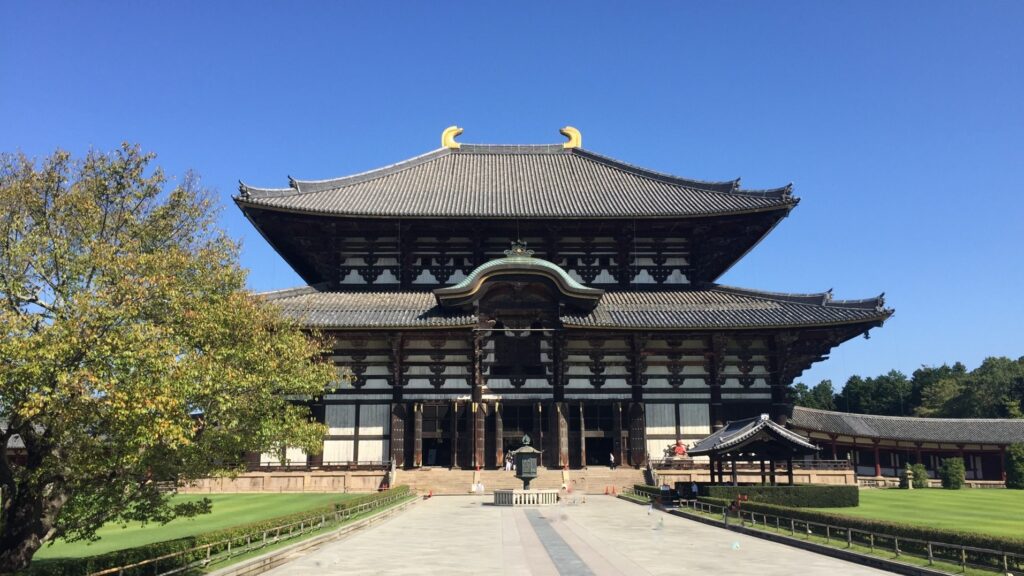
Natural Disasters, Epidemics, and Famines are All Due To My Lack of Virtue
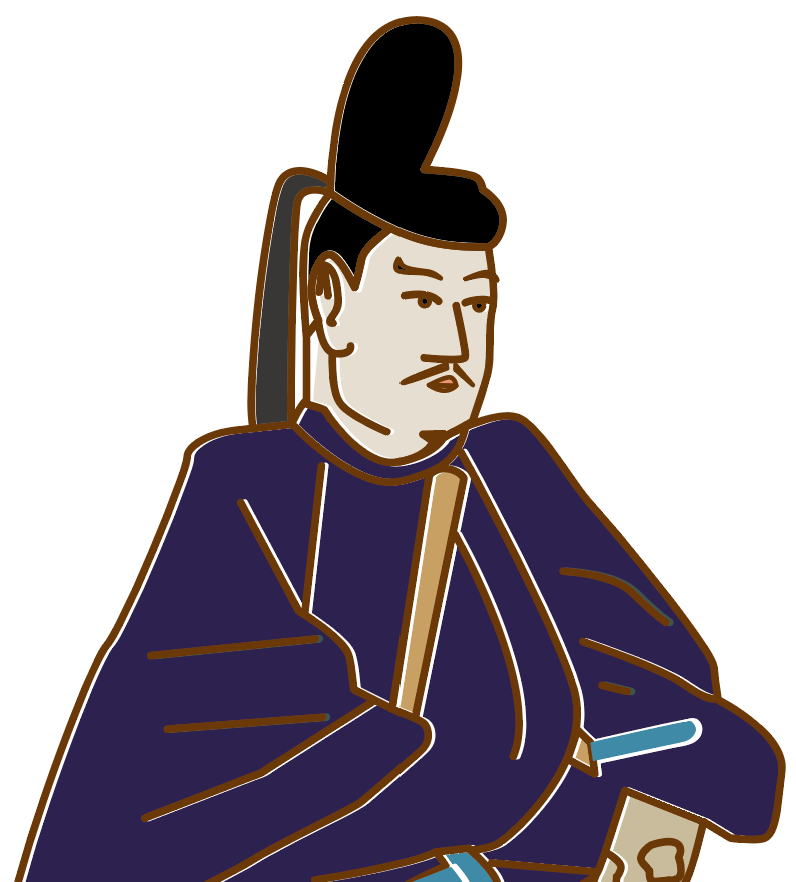
Upon his accession to the throne in 724, the 45th Emperor Shomu (701-756, 聖武天皇) began a government to care for his people as the exerciser of the sovereignty entrusted to him by the Imperial Ancestor, the deity Amaterasu-Omikami. It was a political philosophy that if people had enough food, clothing, and a house to live in, they would naturally have a peaceful world. In 735, however, the situation changed drastically. Drought, famine, major earthquakes, and the smallpox epidemic increased dramatically, impoverishing and throwing the world into turmoil. Emperor Shomu issued a decree in favor of rice payments, amnesty, and tax reductions, stating that "all due to my lack of virtue”. However, the storm of natural disasters and smallpox epidemic did not cease.
Approximately 1 to 1.5 million lives were lost by smallpox, accounting for an estimated 25 to 35% of the population at that time. The mortality rate was comparable to that of the plague in medieval Europe.
Source: by Professor Willam Wayne Fariis in a book of "違和感の日本史 by 本郷和人"
Born as the First Crown Prince of the Fujiwara Clan
Emperor Shomu was born in 701. He was the first crown prince of a lady of a powerful Fujiwara clan, Fujiwara Fuhito. Because of this maternal connection, the four uncles of the Fujiwara family increased their political power as Prince Shomu grew up. At last, they forced their main enemy, the left-wing minister Nagayao, to commit suicide in 729 to allow Shomu to ascend the throne. After the incident, they seized the reins of political power. But things suddenly changed. In 737, the four uncles died one after another. Emperor Shomu feared the Tatari (curse) of Nagayao. He was not only confronted with natural disasters and epidemics but also political power struggles and Tatari.
The Teaching of Kegon Buddhism Fulfilled Shomu's Fondest Wish

With about one-third of the population dying of smallpox, the famine unrelenting, and Prince Nagayao’s Tatari, Emperor Shomu sought help from the power of Buddhism, especially the Kegon teaching. It views the world we live in as expansive, like the opening of a lotus flower, and believes that everything in this world is infinitely interconnected, communicating, cooperating, and overlapping. In short, "the individual builds the whole". Desiring to have this teaching as the foundation of Japan's prosperity, he issued an imperial order to build the provincial temples throughout the nation in 741 and Todaiji Temple and its famous Great Buddha (盧舎那大仏; Vairocana Buddha) in 743 in an attempt to rule the country by connecting each people with a heart of compassion through Buddhist teachings. In this way, he created a mechanism to spread the teachings of Kegon throughout the nation, and called on the people to participate in the construction of the Great Buddha with "a branch of grass and a handful of the soil". This was a huge national project that involved 2.6 million people in total, about half of the population at the time. The people also sought salvation in something. However, acquiring substantial gold for the Great Buddha statue’s construction proved challenging. Fortunately, the discovery of a gold vein in Wakutani Town in Tohoku in 749 facilitated the successful completion of the Great Buddha. In 752, the Todaiji Temple was completed, and a ceremony was held to consecrate the Great Buddha.
The Universe is a Unity and an Individual Builds the Whole
Kegon's idea of "the individual builds the whole" is well expressed in the sculpture on the base of the Great Buddha. The pedestal of the Great Buddha is made up of 28 lotus petals, each depicting the "small thousand worlds" at the bottom, the "medium thousand worlds" in the middle, and 25 horizontal lines depicting the heads of bodhisattvas, palaces, and animals, and more. At the very top, Shakyamuni Buddha and 22 bodhisattvas on either side unite these two worlds. On top of the 28 lotus petals (which in nature represents 1000 petals), Vairocana unifies the worlds together. Please visit Todaiji Temple to experience the Kegon Teaching, which reflects Emperor Shomu’s desire.
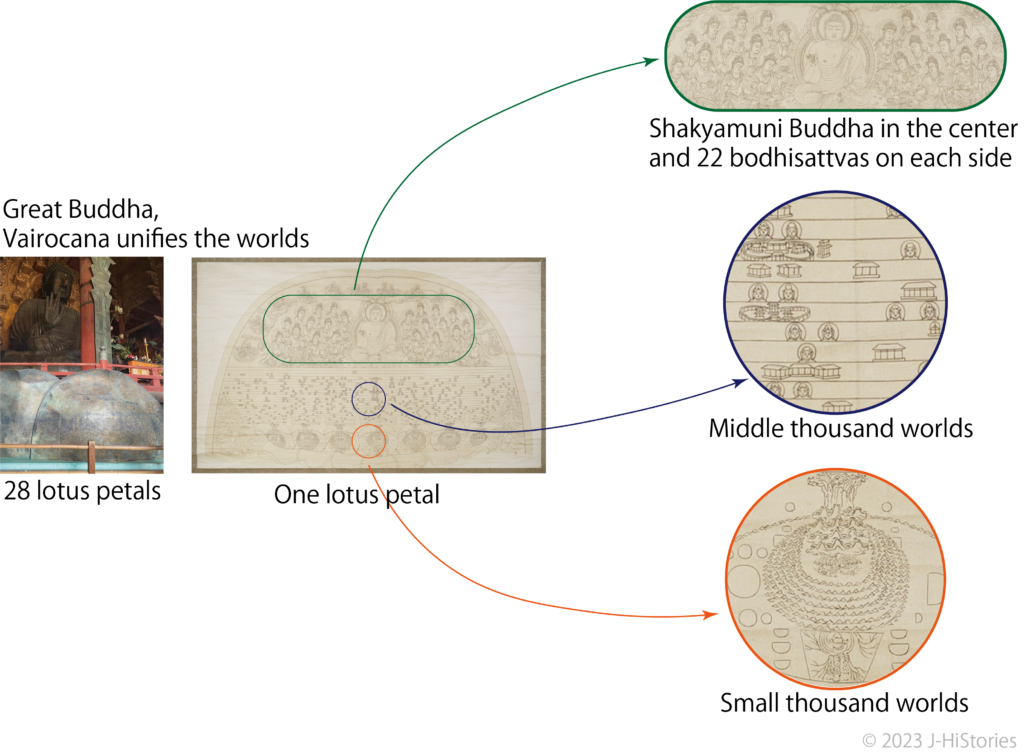
(東大寺大仏蓮弁線刻図模本 宮原柳僊筆 奈良国立博物館所蔵)
A Monarch, Emperor Shomu
Emperor Shomu abdicated the throne in 749. Then, he received the long-awaited religious precepts from Ganjin (688-763, 鑑真), a high priest, in 754. Two years later, he passed away. Despite years of natural disasters and political strife, Emperor Shomu was a monarch by nature. For the sake of the people's peace and tranquility, he supported the impoverished people through a national project of building the Great Buddha not only financially but also mentally through the teachings of Buddha. As a result, the Todaiji Temple and the Great Buddha were essential to the prosperity of all living creatures.
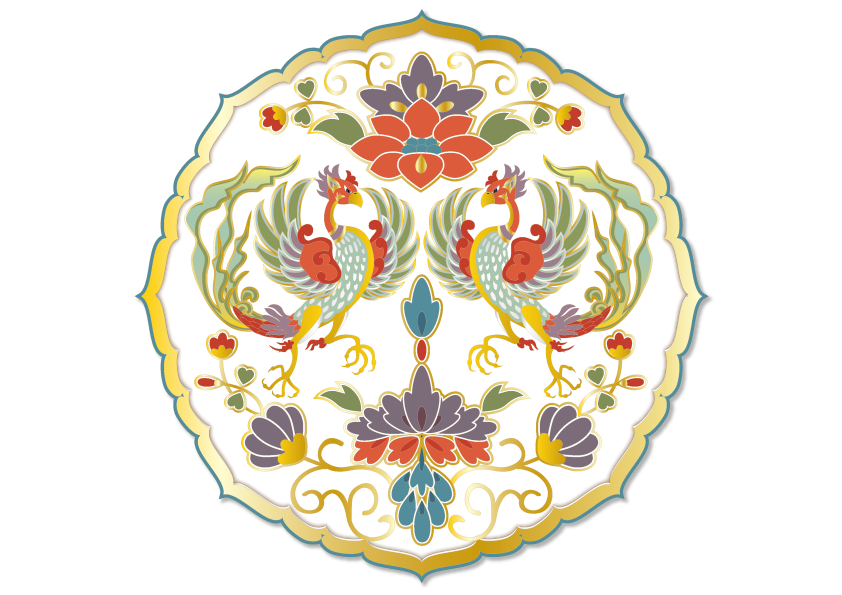
Over 9,000 objects that Emperor Shomu had been fond of during his lifetime were offered to Todaiji by his wife, Empress Komyo. We can enjoy seeing his possessions once a year at the special exhibition in the Nara National Museum, for which the emperor’s order is needed to open the door of the Shosoin Repository of Todaiji to carry out treasures. The beauty of the heirlooms gives a sense of the advanced craft arts of the time.
In addition, the treasures have been preserved and passed down from person to person for over 1300 years, and continue to shine to this day.
Emperor Shomu Timeline
| 701 | Emperor Shomu was born | Age =1 | Asuka Period |
| 707 | Reigning Empress Genmei acscended the throne | - | |
| 710 | Relocation of the capital to Heijo-kyo in Nara from Asuka | - | Nara Period |
| 721 | Reigning Emperor Genmei passed away | - | |
| 724 | Emperor Shomu ascended to the throne | 24 | |
| 729 | Nagayao incident occurred | 29 | |
| 737 | Fujiwara four brothers died of smallpox | 37 | |
| 741 | Emperor Shomu's Imperial order to establish Kokubunji Tenmples | 41 | |
| 743 | Todaiji Great Buddha construction started till 752 | 42-51 | |
| 749 | Emperor Shomu abdicated from the throne | 49 | |
| 756 | The retired Emperor Shomu passed away | 56 | |
| 794 | The relocation of the capital to the city to Heian-kyo in Kyoto | - | Heian Period |
Recommendations to visit
- Access: 10 min from JR or Kintetsu Nara Station. Take bus #77 bound for Kasugataisha Honden (春日大社本殿). Get off at Todaiji Daibutsuden (東大寺大仏殿) bus stop
- Access: 7 min from JR or Kintetsu Nara Station. Take bus #77 bound for Kasugataisha Honden (春日大社本殿). Get off at the National Museum (国立博物館) bus stop

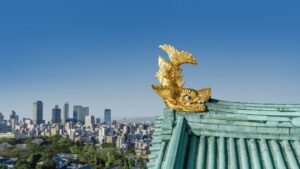

One thought on “Todaiji Temple and Great Buddha, Emperor Shomu's Wish to Settle Chaotic Turmoil”
Comments are closed.